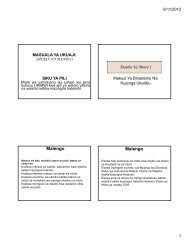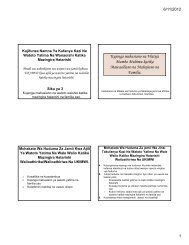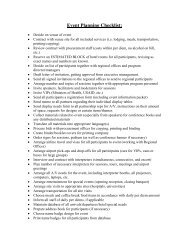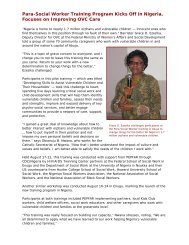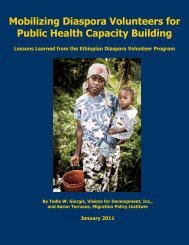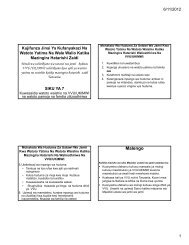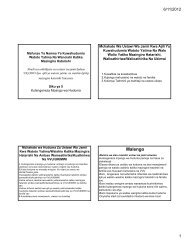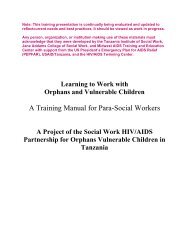Day 6 Notes - HIV/AIDS Twinning Center
Day 6 Notes - HIV/AIDS Twinning Center
Day 6 Notes - HIV/AIDS Twinning Center
- No tags were found...
Create successful ePaper yourself
Turn your PDF publications into a flip-book with our unique Google optimized e-Paper software.
Note: This training material is continually being evaluated and updated to reflect current needs and bestpractices therefore it should be viewed as work in progress.Any person, organization, or institution making use of these materials must acknowledge that they weredeveloped by the Tanzania Institute of Social Work, Jane Addams College of Social Work, and theMidwest <strong>AIDS</strong> Training and Education <strong>Center</strong> with support from the US President’s Emergency Plan for<strong>AIDS</strong> Relief (PEPFAR), USAID/Tanzania, and the American International Health Alliance’s <strong>HIV</strong>/<strong>AIDS</strong><strong>Twinning</strong> <strong>Center</strong>.<strong>Day</strong> 6:Support and Behavior Change for Vulnerable Childrenand Their FamiliesRecap — Review of previous day and overview of coming dayNote: Transition from <strong>Day</strong> Five: Developing and Implementing a Plan of Support<strong>Day</strong> Six builds directly on the concepts and practice of case management explored in-depth on<strong>Day</strong> Five. <strong>Day</strong> Six focuses on the actual development of plans of support and how to supportthe behavior changes required to implement a plan of support. It also focuses on the role of thePara Social Worker in effecting change and how the Para Social Worker can support andstrengthen the family and child at risk.Review of Social Work Process Social Work Process for Working with Most VulnerableChildren and their Families and Location of this <strong>Day</strong>’s Activities (Slides 2-3)1. Identifying Vulnerable Children and their Families2. Engaging Vulnerable Children and Families3. Assessing the Strengths and Needs of Vulnerable Children and their Families4. Developing a Plan of Services for Vulnerable Children and their Families5. Implementing the Plan of Services• Identifying and Referral to Other Resources• Providing direct services: problem solving, support and coordination• Empowering and supporting caregivers• Addressing <strong>HIV</strong> related prevention and care concerns6. Evaluating Progress, Revising Service Plan and Following Up Through OngoingCase Management, Family Support and AdvocacyLearning Activity:• Review the social work process and discuss elements of behavior changerelevant to points five and six above.Trainer Tip:
At the end of the day recap before the small group workshop, it might be useful to askhow participants think their new knowledge of behavior change helps them to gain abroader understanding of the social work process.Objectives for the <strong>Day</strong> (Slide 4)At the end of the <strong>Day</strong> Para Social Workers will be able to:• Explain the basis of behavior change and the stages of change model• Explain the concept of risk reduction and how to support risk reduction decisions• Demonstrate skills in family-based problem solving and risk reduction forvulnerable children, families and caregivers• Explain the process of grief and loss in the context of vulnerable children andfamiliesTopical Outline OverviewThere are two major sections of this day:Behavior Change• What it is• Risk Reduction• Stages of Change• Problem Solving• The role of the Para Social Worker focusing on the problem solving modelThe Life of the Child Experiencing Grief and Loss• Developmental review of the grief process• Review of how a caregiver can support the grief process• Review of how a Para Social Worker supports behavior change and creates aplan to support behavior change and/or children and families experiencing griefand loss. These plans should refer back to the concepts of case managementtaught in <strong>Day</strong> Five1. Planning for Behavior Change (Slides 5-9)a. Para Social Worker as a change agent supporting vulnerable children andtheir familiesb. Aspects of planned behavior change include adapting change based onenvironment, altering change based on internal motivation and modifyingbehavior target based on circumstances.c. Change is affected by:• Developmental growth, maturity• Changes in situation: family, income, external situations• Other factors within the person or the situation: peer impact,increasing knowledge, family/community pressure, changes inhealth and illness, policy and community impactsLearning Activities:• Brainstorm and discuss how ordinary behaviors are changed.
ooAsk for an example of a behavior to change. Participants will suggestexamples like changing a habit, chaning eating or smoking behaviorlearning how to take a pill at a certain time of day in a certain way.This example of change will continue to be used to illustrate key pointsthroughout the day. Note, that the example is probably going to have tobe focused on children and families.• Discuss how changing behavior in reaction to extreme need or a crisis feelsdifferent from changing behavior because a free and conscious decision is madeto change. Focus the discussion on how this might be different and how it mightfeel different can frame the entire discussion of the day.• Discuss the social context of behavior change: the importance of development,for instance peer pressure; the importance of environment and communitysupport. Illustrate these concepts in group discussion of how change is affectedby families, communities, peer groups, school and, of course, illness.Trainer Tips:• The initial examples of behavioral change should be simple and then should startlooking at how people dealing with OVC issues and/or <strong>HIV</strong> issues deal withchanges which are much more difficult• If an example related to pill taking is introduced here, it can be referenced to on<strong>Day</strong> 7 in the sections on adherence• The other underlying issue in this section on behavior change is that we aretalking about people who are being forced to change because of illness, povertyor death; or people for whom acquiring the resources for or the insight required tochange is difficult• Consider the question, “In a crisis what is the role of the Para Social Worker whois trying to help a family transition into a better circumstance?” This questioncould frame a discussion of professionalism and the trainer might makereference to the kinds of changes required to emerge as a para professional inthe group case conference situation or the kinds of insight gained in the previousday’s discussion of boundaries, or in <strong>Day</strong> Four’s discussion of the strength’sapproach• Given that behavior change is difficult, this section refers constantly to the role ofthe Para Social Worker in identifying, implementing and supporting behaviorchange. But, also, this section references the concepts embedded in the sectionson identification and engagement. We must always stay with the client; we startfrom where they are and support them and encourage them and we provideresources to implement.2. Risk Reduction (Slides 10-14)a. What is Risk Reduction?• Model of behavior change that can be helpful in understanding how behaviorschange and how para social workers can be helpful in that process. It focus onmodifying the risk instead of modifying the action/behavior• Risk Reduction strategies reduce harm while giving the client the space, time andpositive feedback required for permanent behavior change• Risk Reduction may provide useful ways to change over time by reducingnegative behaviors or increasing positive ones
Learning Activities:Trainer Tips:b. What are some examples of risk reduction behaviors (negative or positive)c. Roles of the Para Social Worker in planned behavior changed. Planned change - an approach to problem solving based on:1) Problem assessment2) Knowledge of the individual’s readiness for change3) Change focused intervention4) Para Social Worker functions as a change agent with the child/family andjointly plans with them for change5) Risk reduction and behavior changee. Risk reduction or harm reduction approaches assume that:1) Behavior change is a process that occurs over time rather than a singleevent2) Risk reduction involves many factors, including psychosocial relationships aswell as other social and environmental factorsf. Risk reduction strategies must be broken into small enough steps for the personto do successfully• Pick a behavior for discussion involving personal risk or risk to others that would bewell known to the participants.• Talk about why risk reduction is a very good first step. If smoking is used as anexample, talk about the element of addiction. Alcohol abuse is also a very goodsubject around which to frame this discussion.• Strategize through a brainstorm how that behavior could be lessened and thereforemaking it less risky.• The concept of risk reduction is often difficult. Most people, when they think aboutchanging a behavior, think about stopping the behavior completely. However, when thebehavior involves risk and difficult physical, mental, emotional or situational aspects(think of smoking or changing eating behavior or reducing fighting with a spouse or otherfamily member), reducing the behavior might be a better and more realistic strategy.• The slides suggest that the trainer might want to talk about reducing the number ofsexual partners, but the example chosen could also be more general: Smoking, overeating and alcohol abuse are very common and the discussion of the risk related tomultiple sexual partners will occur on the next day.• Slides 13-14 are transitional to the idea that the person engaging in risky behavior canplan to change. Planning to change is a theme than runs through <strong>Day</strong>s 5 and 6 of thiscurriculum. Planning to change might require support from a Para Social Worker and itmight require a strategic process. For example, if the discussion centers around alcoholabuse and the person always abuses by going to a bar after work, guide the discussiontoward strategies which might change the behavior, for example, changing the route ortime or the people who lead to the behavior.• Emphasize the fact that the role of the Para Social Worker is to support the client wherethey are and to help them come to decision to change and then to support the change
(recognizing that the change may require additional resources for example) and alsorecognizing that the root cause of risky behavior might not be obvious. For example,many men drink not because they want to, but because they are depressed and angryabout their inability to provide for their families or because they have no other way tohelp themselves to feel better. This is a difficult discussion and perhaps it will be easierand more specific to bring this aspect of the discussion out in the Small GroupWorkshop.
3. Stages of Change (Slides 15-26)a. Circle of Change• The model “circle of change” describes the stages of change each person goesthrough on the journey to changing behavior• This model is not presented to suggest that change is simple or easy, but ratherto emphasize that change is complex and involves a process• Para Social Workers can assess where a person is in the change process andchoose interventions appropriate to that stage• This helps Para Social Workers “begin where the person is”b. The Stages of Change No change planned (Pre-contemplation) Thinking about change (Contemplation) Deciding to change (Decision) Changing behavior (Action) Continuing the change (Maintenance) Relapse returning to the harmful behavior (Relapse)Learning Activities:• Ask the groups the steps they use to make a change in their behavior or the behavior ofone of their own children• Present an interactive lecture discussion, getting feedback and questions from eachslide in the series.• Demonstrate the steps of behavior change with the trainers role playing various stagesof a behavior change, then ask the participants to find a word to describe each stage
• Discuss how the process can be circular, or how the client can go from relapse todecision, skipping some parts of the circleTraining Tips:• The main idea to communicate for this section is the fact that change occurs in smallpieces and there are a variety of phases, however they may not always occur the sameway. Change may be one step forward, two steps backward• These stages describe a continuing process; they are not a formula or a checklist forchanging behavior.4. The Role of the Para Social Worker as an Agent for Problem Solving (Slides 27-39)Learning Activities:• Ask the participants to think about what are the steps in solving a problem, specificallyas it applies to vulnerable children and their families. Brainstorm their responses.• Summarize the response, raise questions and “control the discuss” (e.g. when theparticipants begin to give the same answers move on to the next question)• Anchor the discussion within the context of a case. Either create a case to fit the partsthat are seem natural to illustrate, or even better, use Mwakaila because as a groupcase it provides general reference for everyone.a. Roles of Para Social Worker: Helping Families to Solve Problems• Helpers• Links to services in the community (discussed on <strong>Day</strong> 5)• Family and community advocatesb. Who are the Community Resources Who Can Help Solve Problems?c. Para Social Worker as an Agent for Problem SolvingLearning Activity:• Brainstorm a list of how Para Social Workers help solve problems• Discuss and connect with slides 31-32.d. Overview: The Problem Solving Model• Building the Relationship• Exploring the Problem• Understanding the Problem• Planning for Action and Evaluating Results
5. Life of a Child: Grief and Loss (Slides 40-60)Learner Activity:• Conduct an interactive discussion with the participants, using the slides as reference andfor direction• Pose questions about the participants’ own experience and ideas about how to deal withgrief and loss• Specific rituals or spiritual approaches may be discussed as well as what happens whenan individual does not have a chance to experience these rituals• These sections can be unified through a group role play of a child losing a parent.Develop the role play so that the circumstances of the loss are the same, but the child’sage change: a 3-year-old, a 6-year-old, a 10-year-old, a 13-year-old, an 18-year-old• The trainer can also focus this discussion to look at gender roles in grieving by ageWould/could a 13-year-old girl express her grief at the loss of her mother differently forma 13-year-old boy? If the role play technique is used, be sure to give the playersinstructions and be sure to make it very brief.Trainer Tips:• This section often creates great interest by participants as everyone present hasexperienced grief and loss and everybody has something to say and this may not havebeen discussed in the cultural context• The major challenge to the trainer is to control the discussion so that it proceeds in linewith the slides and doesn’t become a group therapy session, focusing on a particularloss given as an example by a member of the learning community. This is a delicatebalance because successful teaching of this topic depends on anchoring the knowledgeto be transferred in the experience of the learning community; at the same time, thediscussion cannot focus on personal problems or issues. If the conversation veerstoward a particular personal experience, the “Parking Lot” can provide an escape valve,so that the trainer can then refocus the discussion on the slides. If this happens morethan once, change teaching techniques to a lecture discussion and go through the slides• The second major point of this section is that, like behavior change, the grief processhas stages (shock, anger, bargaining, sadness, acceptance – see slide 45) and it iscircular or at least non-linear, that sometimes oscillating back and forth or among thesestages of grief at various times• Finally, it is extremely important to emphasize that children experience grief according totheir developmental stage. This process of developmental grieving is explained in Slides46-48 from a different perspective in Slides 53-58.• Inexperienced role players exhibiting grief in front of a group just tend to weep and wailas an expression of grief. Think carefully about how grief is really expressed: silence,withdrawal, anger, ignoring the situation, acting out, running away, engaging in riskybehaviors, etc. If the role play just involves a lot of screaming, ask the audience tocomment how grief is experienced or how they have seen it in various circumstances.Topic Outlinea. Overview• All children experience grief and loss when separated from their parent(s)whether by illness, death, or abandonment
• Like other aspects of human development, grief and loss depends on gender anddevelopmental stage among other factors• Feelings about grief and loss may cause many behaviors that indicate grief andloss, for instance: Anger, Sadness, Hyperactivity, Being Withdrawn• These feelings are appropriate but may produce behavior s that are harmful tothe child, others, or propertyb. The Grief Process Grief, like behavior change, is a process that may assume a circular form.People experiencing grief and loss may revert to prior stages depending uponother circumstances. An unrelated event or trauma may evoke a renewed griefreaction for the earlier loss. What do you think are stages in the process of grieving? Brainstorm Stages of Grieving: Shock/Denial, Anger, Bargaining, Sadness and Depression,Acceptanceo Note: Everyone may grieve differently, may not go through stages inorder and may move back and forth between the stages. Developmental Grievingo Sometimes children seem to have reached acceptance but have simply“bottled up” their feelings. These strong feelings may erupt at a later timeo Multiple losses trigger strong, but unresolved emotions from previous losseso The pain of separation and loss is a type of traumao Children can become stuck at one level, or even go back to an earlier level ofdevelopmento When we see a child who angry this may reflect their experiencing loss andpain (“Whenever you see anger, look for the pain”)o Other children may appear charming and carefree. This is a way of hiding thepain of losso Events and Contexts that Trigger Grieving: Anniversaries, Birthdays,Holidays, Special songs, etc.Factors that Affect Ability to Grieveo Nature of the losso Health and self-esteemo Age at time of each losso Degree of attachment to lost persono The intrinsic vulnerability of the person experiencing the losso Factors that Affect Ability to Grieveo Circumstances causing losso Number of previous separationso Support and help provided during the process of the loss (before, during orafter)c. How the Para Social Worker helps the child• Shift child’s focus from feeling worthless to strengths and hope• Provide information• Assure children are connected in terms of personal relationships and withingreater environment• Secure financial support for the child.
• Involve the child in age appropriate groups: the family, groups focusing on issuesof interest to the child, etc.• Help the child perform significant roles in the family, at school, within peergroups, etc.• Help identify experiences that provide a source of Joy• Teach Constructive Values and Attitudes• Help Maintain or Develop Personal Historyd. How the Para Social Worker helps the caregivers to understand that:• as child grows and develops, all the steps in the grieving process may need to beexpressed over and over again• Grieving children may be confused about parent-child relationships.• Helping the child takes persistence, skill, patience• Helping the child requires continuing help over time• Child’s needs and feelings are important• Child is safe and is going to be cared for• Child’s needs can be expressed and met• Parents can be consistent and trusted6. Summary (Slide 61)Learning Activities:Ask participants to recall each topic covered today and restate the major topics:o Behavior changeo Risk Reductiono Stages of Changeo Problem Solving Modelo Grief and Loss for a child• Process of Grieving• Developmental aspectso Grief and Loss from the Caregiver PerspectiveFocus this discussion by looking at the role of the Para Social Worker in each ofthe topicsThe trainer might end by noting that this same role has also been described ascentral to case management and case planning as well as to outreach,identification, engagement and assessmentTrainer Tip:The discussion should make it clear that the role of the Para Social Worker, while largeand difficult, is to be a helper and supporter over time and specifically to refer difficultcases to a higher level professional and to acquire resources required to stabilizechildren and families in these difficult circumstances.Recap of <strong>Day</strong> 6 & Preview of <strong>Day</strong> 7



